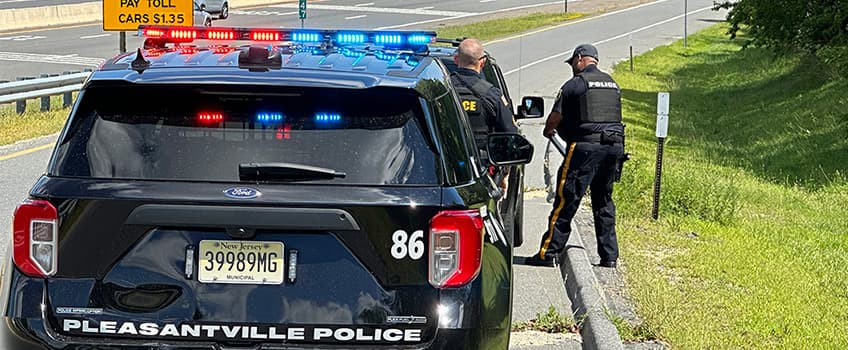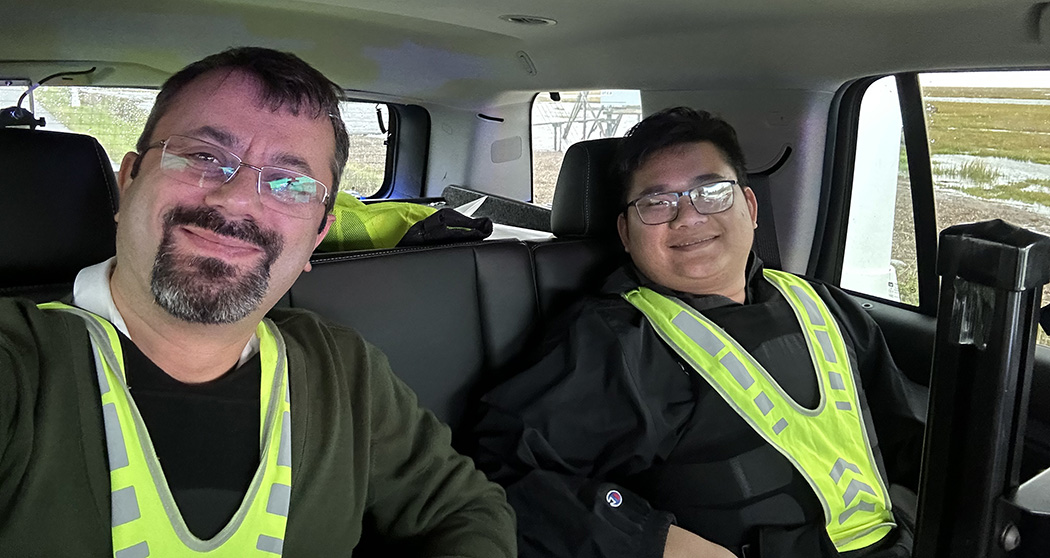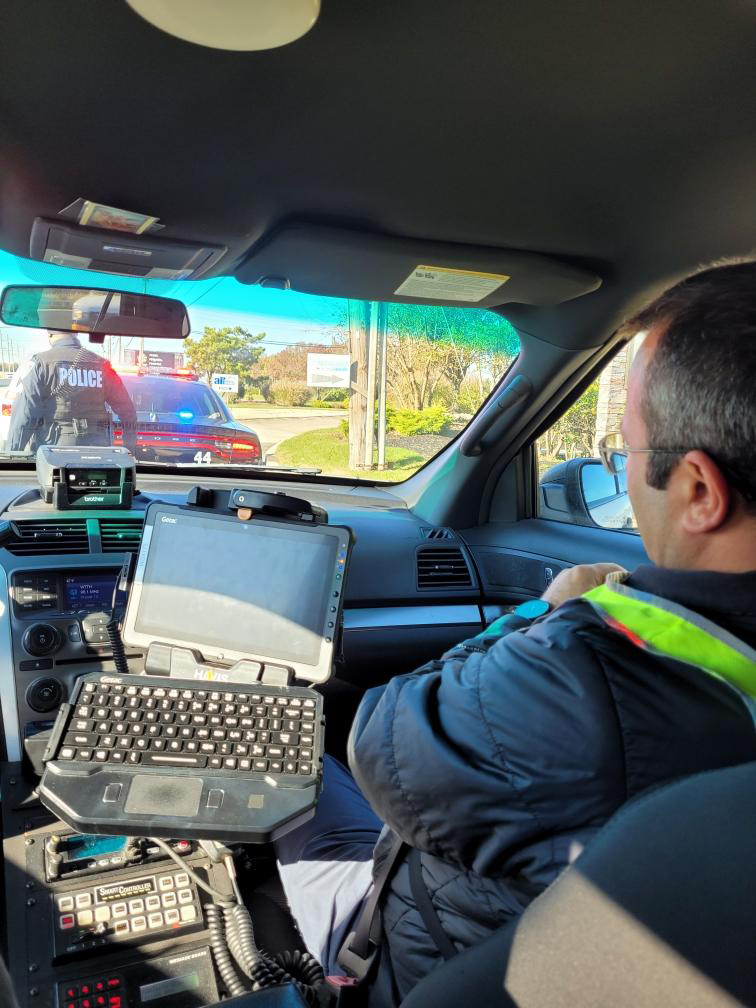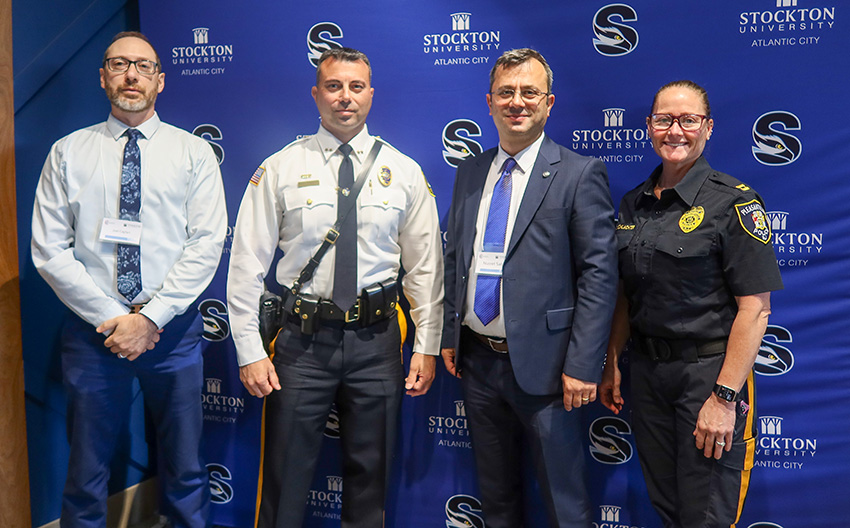Traffic Stop Project Improves Public Trust in Police

Members of the Pleasantville Police Department talk to a motorist that was pulled over for a traffic stop as part of the EPJETS research project.
Atlantic City, N.J. — Nearly 85% of all police-initiated interactions with citizens occur during a traffic stop — by far the most common way the public encounters law enforcement.
A group of researchers, led by Stockton University professors and students, believe enhancing this method of contact may improve the relationship between the police and the community. Recent tragic incidents during traffic stops, including the death of Tyre Nichols by the Memphis Police Department in 2023 and the death of George Floyd in 2020 at the hands of a Minneapolis police officer, have led to trust in police dipping to its lowest level since 1993, according to a recent Gallup Survey.
“Current police training is suggesting that officers keep interactions short when making traffic stops. Just keep it short and let the driver go,” said Nusret Sahin, Stockton assistant professor of Criminal Justice. “I think we challenge this in a good way because our findings show that when officers spend more time it has very positive impacts from the citizens’ perspective.”

Stockton Assistant Professor of Criminal Justice Nusret Sahin, left, and Stockton student Tai Bui, of Atlantic City, in an Atlantic City police car as part of the EPJETS program. Bui had the opportunity to interview motorists who agreed to be part of the program.
Sahin is the lead investigator on the project titled Enhancing Procedural-Justness of Encounters Through Substantiation (EPJETS). He’s joined on the research team by co-principal investigators Manish Madan, associate professor of Criminal Justice at Stockton; Joel Caplan, professor at the Rutgers School of Criminal Justice; and Rob Voigt, assistant professor of Linguistics at Northwestern University.
The group announced their findings at a news conference on June 10 at Stockton’s Atlantic City campus, including how the protocol:
- Increased public trust in law enforcement and enhanced cooperation with police.
- Increased the level of support for traffic enforcement and enhanced the legitimacy of the traffic stops.
- Altered the perceptions of police professionalism related to the use of body-worn cameras.
The project is funded by a $702,956 grant from the U.S. Department of Justice. The research team conducted the project with the Atlantic City and Pleasantville police departments from October 2022 to June 2024. During that time, 1,423 drivers were stopped for speeding — 752 were part of the control group where officers gave citizens a standard short interaction, and 671 drivers were in the experimental group with the new protocol. In that group, the drivers were given the following by police:
- A procedural justice-oriented script rooted in a message of dignity, respect, neutrality and fairness.
- A pamphlet, researched and designed by Stockton students using risk-terrain modeling, that detailed the areas of the cities that had the most traffic accidents.
- A survey given by Stockton students about the motorists’ thoughts on the new protocol.
- Access to body camera footage from the police officer so the drivers could go back about a week later and watch the interaction.
Providing the body camera footage allowed citizens to see how they interacted with the police and gave them the peace of mind that the traffic stop was being recorded and could be seen by the officer’s supervisor, Sahin said.
“Citizens are concerned during traffic stops. It’s a very stressful moment for some people,” he said. “We are alleviating that stress. The officers are just telling people, ‘This is for your safety.’ If you want a professional police service, if you want to enhance trust between police and the citizens, then our protocol offers a simple and easy way to do that.”

Sahin is the lead investigator on the EPJETS project, which is funded by a $702.956 grant from the U.S. Department of Justice.
Atlantic City Police Chief James Sarkos said he was extremely proud and enthusiastic for his department’s participation in the research, and specifically how it involved procedural justice.
“This collaboration marked a significant milestone in our ongoing efforts to enhance law enforcement practices through training and community engagement,” Sarkos said during the news conference. “Our collaboration with Dr. Sahin and Stockton University underscores our dedication to working with academia. Through this partnership, we are able to leverage academic research to inform our practices, making our community safer, our policing more effective and helping us to stay at the forefront of modern policing techniques.”
Sarkos added that this is the first time an agency has made traffic stop video footage available to motorists after the stops and to test its impact.
“We are proud that we not only serve our citizens but also are being accountable for our practices,” he said.
Making the footage available also had another surprising impact on citizens, Sahin said.
“The people who received our protocol and who were offered access to the body camera footage found police more professional than the control group,” he said.
Another big part of the project is the involvement of students in completing the research. Sahin said seven Stockton students performed tasks such as researched crime statistics, created the safety brochure provided to motorists, downloaded the body camera video from police, blurred any faces or other identifiers and then uploaded the video to a website for citizens to view. The students also went on ride-alongs with police officers and Stockton professors to interview the motorists during stops.
“It was so interesting to work with police officers one-on-one so closely and see how they interact with citizens,” said Karolina Kotula, who was outfitted with a protective bulletproof vest and a fluorescent-colored safety vest during the stops. “You think that words don’t make a difference until you actually see how people react between an experimental stop after an officer follows the script and just a regular traffic stop.”
Kotula, who graduated in December with a Criminal Justice degree, said the work on the project had a huge impact on her and changed her perceptions about policing so much that she’s now in the process of becoming a police officer.
“Nowadays with everything going on, with the miscommunications with the community and their perceptions of police, this will make a huge difference in how they think and feel with police officers,” said the Garfield native.
While both local police departments were pleased with the study’s results, Sahin believes EPJETS has potential implications for policing practices on a national scale. Over the next few months, he will put together a report on the findings in the hopes that it can be published. He also has plans to attend several upcoming conferences to promote the findings, including the Police Security Expo in Atlantic City at the end of June and the National Institute of Justice Research Conference in Pittsburgh in the fall.
“Building trust between the police and the community is crucial for effective policing and public safety,” Sahin said. “Through this project, we tested whether the EPJETS model enhances citizen attitudes and confidence in the police, particularly during traffic stops. Using a robust research methodology, we found that the answer is yes.”
— Story by Mark Melhorn

From left, Joel Caplan, Rutgers University professor; James Sarkos, Atlantic City police chief; Nusret Sahin, Stockton University assistant professor; and Stacey Schlachter, Pleasantville interim police chief.


